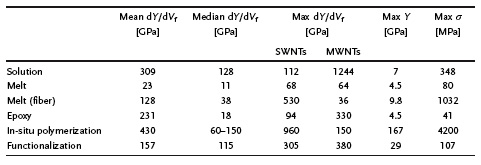| Posted: Apr 03, 2006 | |
Ultra-strong composite materials with nanotubes |
|
| (Nanowerk Spotlight) Carbon nanotubes (CNTs) are five times less dense than steel and approximately 30 times stronger. Their mechanical properties make them ideal candidates for the mechanical reinforcement of polymers. CNTs are the ultimate mechanical filler with very low densities and Young moduli (the measurement of stiffness of a material) superior to all other carbon fibers. | |
| A recent publication by three researchers from the University of Dublin Trinity College in Ireland, Jonathan Coleman, Umar Khan and Yurii Gun'ko, explores the progress that has already been made in the area of mechanical reinforcement of polymers using CNTs. Their review, titled "Mechanical Reinforcement of Polymers Using Carbon Nanotubes" was published in the Feb. 22, 2006 online edition of Advanced Materials. | |
| Several mechanical properties can be targeted for reinforcement of polymers: the Young modulus, tensile strength (the stress required to break a material) and toughness (the work done to break a material). According to the Irish researchers, a large amount of work will have to be done before the most is made of the exceptional mechanical properties of CNTs. | |
| "There are four main system requirements for effective reinforcement of polymers" Gun'ko told Nanowerk. "These are a large aspect ratio, good dispersion, alignment, and interfacial stress transfer." | |
| The Trinity College researchers explain: "Aspect ratio must be large to maximize the load transfer to the nanotubes. Dispersion is a more fundamental issue as CNTs must be uniformly dispersed to achieve efficient load transfer to the nanotube network and achieve a more uniform stress distribution. Alignment is a less crucial issue. While it is necessary to maximize strength and stiffness, it is not always beneficial. Aligned composites have very anisotropic mechanical properties, which may need to be avoided in bulk samples. In fibers, however, alignment has no downside and is a good way to maximize reinforcement." | |
| "Probably the most important requirement for a CNT-reinforced composite" says Coleman "is that external stresses applied to the composite as a whole are efficiently transferred to the CNTs, allowing them to take a disproportionate share of the load." | |
| There are several traditional methods for processing polymer composites. The most common method for preparing polymer–CNT composites is to mix the CNTs and polymer in a suitable solvent before evaporating the solvent to form a composite film. If the polymer types used are insoluble, in particular thermoplastic polymers, melt processing is used as a common alternative. Finally, there are various methods of chemical processing of CNT–polymer composites, involving in-situ polymerization and covalent functionalization of CNTs with polymer molecules. | |
| A number of novel CNT-polymer composite preparation methods have been reported for the fabrication of composite films and composite fibers that are distinct from the traditional methods mentioned above. They include the layer-by-layer (LBL) assembly method, Buchner filtration, electrospinning and coagulation spinning. | |
| By critically analyzing and comparing the mechanical properties of various CNT–polymer composites prepared by different techniques the researchers conclude that composites based on chemically modified nanotubes show the best results. Of all the processing methods, the overall results are worst for the melt-based systems. An interesting conclusion of these results is that it is premature to assume that SWNTs are superior, as many commentators have. Another disappointing fact is that strength enhancement has been poor except in the case of composite fibers. | |
 | |
| Summary and comparison of reinforcement of SWNT and MWNT composites fabricated by various methods, where Y is the composite Young’s modulus, δ is the composite strength, and Vf is the nanotube volume fraction. (Reproduced with permission from Wiley) | |
| "These results suggest that there are three main areas where significant improvement is urgently needed" says Gun'ko. "The problems with mechanical reinforcement of melt processed composites must be addressed. Any CNT-reinforced composites produced at an industrial level are likely to be produced by melt processing." | |
| "Another significant problem" adds Coleman, "is the disappointing values for composite strength and, a more important issue that is probably a partial cause of this, is that in very few cases large volume fractions are attained." | |
| Going forward, research needs to be done to find the optimum tube type and then maximize CNT solubility, dispersion (and hence, volume fraction), and stress transfer. All these factors can be addressed as one by functionalization of the nanotubes. Once the CNTs have been fully optimized, the mechanical properties that are attainable can be considered. | |
 By
Michael
Berger
– Michael is author of three books by the Royal Society of Chemistry:
Nano-Society: Pushing the Boundaries of Technology,
Nanotechnology: The Future is Tiny, and
Nanoengineering: The Skills and Tools Making Technology Invisible
Copyright ©
Nanowerk LLC
By
Michael
Berger
– Michael is author of three books by the Royal Society of Chemistry:
Nano-Society: Pushing the Boundaries of Technology,
Nanotechnology: The Future is Tiny, and
Nanoengineering: The Skills and Tools Making Technology Invisible
Copyright ©
Nanowerk LLC
|
|
Become a Spotlight guest author! Join our large and growing group of guest contributors. Have you just published a scientific paper or have other exciting developments to share with the nanotechnology community? Here is how to publish on nanowerk.com.
